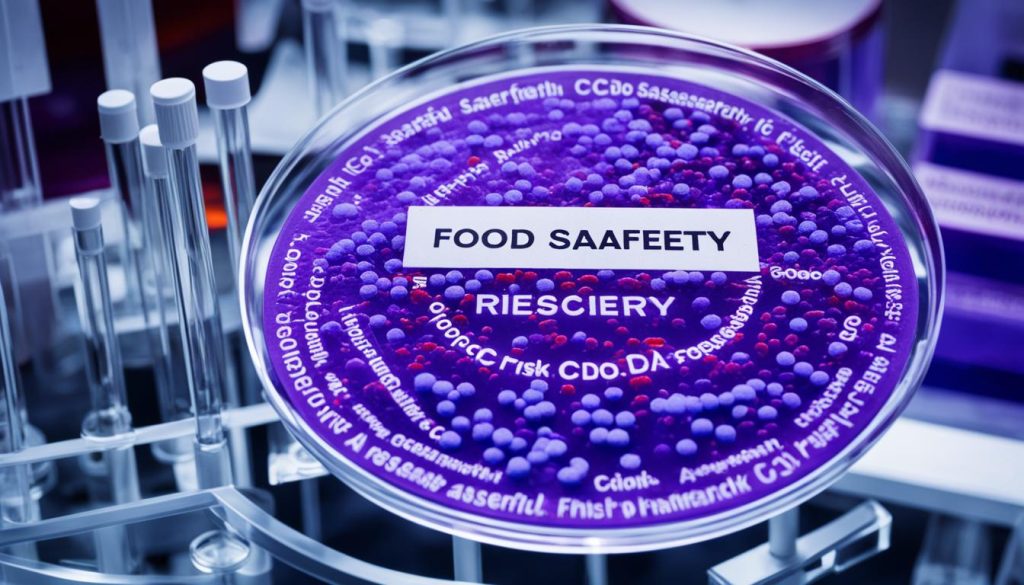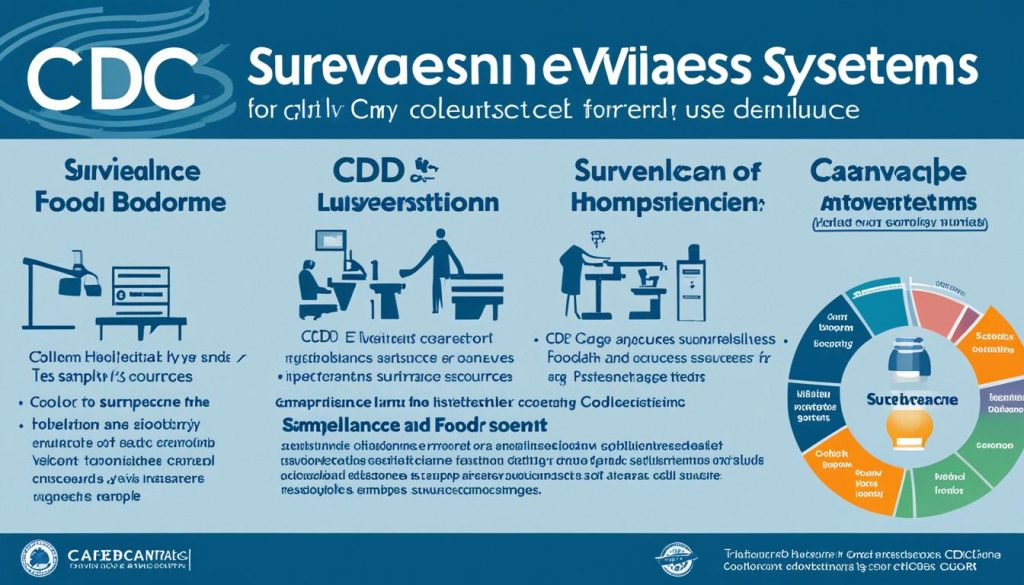The Centers for Disease Control and Prevention (CDC) holds a fundamental role in the realm of public health, particularly in maintaining food safety standards across the nation. As guardians of public health, the CDC’s role in food safety is multi-faceted, extending from rigorous monitoring and surveillance of foodborne illnesses to spearheading preventive initiatives positioned to safeguard the populace. With the primary goal of staving off foodborne pathogens and reducing the prevalence of such illnesses, the CDC’s strategies are imperative for assuring a safe food supply and bolstering consumer confidence.
In its steadfast commitment to quelling the threats posed by foodborne diseases, the CDC’s role in preventing foodborne illnesses manifests through a comprehensive approach that includes advanced molecular detection methods and steadfast partnerships with other government agencies. Through these concerted efforts, the agency stands at the forefront of protecting our communities from the dangers of contaminated food sources, highlighting the importance of CDC in food safety infrastructure nationwide.
Key Takeaways
- The CDC performs critical monitoring and surveillance of foodborne diseases to ensure public health and safety.
- Prevention and control of foodborne illnesses are central to the CDC’s multifaceted role in food safety.
- Advanced surveillance systems like PulseNet play a key role in the CDC’s analysis and response strategies.
- Effective collaborations with the FDA and USDA reinforce the CDC’s efforts in managing foodborne illness outbreaks.
- The CDC’s contributions are pivotal in forming food safety policies and promoting research and risk assessment.
- Public guidance and educational resources provided by the CDC are instrumental in fostering safe food handling practices.
- Partnerships and international collaborations further the CDC’s mission for an integrated and effective food safety system.
Understanding CDC’s Monitoring and Surveillance of Foodborne Illnesses
The Centers for Disease Control and Prevention (CDC) is pivotal in safeguarding public health through persistent CDC foodborne illness monitoring. By consistently capturing and scrutinizing data from a plethora of sources such as health departments and laboratories nationwide, the CDC strives to mitigate and prevent the hazards of foodborne diseases.
Investigation of Multistate Foodborne Disease Outbreaks
At the heart of CDC outbreak investigation efforts is the rigorous examination of symptomatic evidence, striving to pinpoint sources of contamination. When a multistate foodborne disease outbreak arises, CDC specialists leap into action, employing epidemiological expertise to ascertain causative factors and execute measures to staunch the spread and avert future incidents.
Analysis and Response through Surveillance Systems such as PulseNet
The efficacy of CDC surveillance systems such as PulseNet cannot be overstated. PulseNet represents a vital coalition of laboratories using advanced DNA fingerprinting to trace patterns of foodborne illnesses. The network’s reach and precision enable the CDC to deliver timely analyses and responses that are crucial for outbreak management and the protection of public health.
Collaboration with State and Federal Agencies for Effective Outbreak Control
CDC collaboration for outbreak control involves a multidisciplinary approach bridging various state and federal agencies, including the Food and Drug Administration (FDA) and the United States Department of Agriculture (USDA). This collaborative spirit is foundational to crafting a unified response to foodborne illness outbreaks, encompassing the dissemination of information and the implementation of preventive strategies for comprehensive outbreak control.
| CDC Function | Operational Detail | Collaborative Agency |
|---|---|---|
| Data Collection | Gathering illness reports from state/local entities | Health Departments |
| Outbreak Investigation | Identifying contamination source, controlling spread | FDA, USDA |
| Surveillance Systems | Tracking illness patterns with PulseNet DNA fingerprinting | PulseNet Laboratories |
| Outbreak Control | Coordinating preventative measures | Federal and State Agencies |
The integrated role of the CDC in surveillance, investigation, and collaboration forms the backbone of the nation’s efforts in combating foodborne illnesses. It is a testament to the CDC’s unwavering commitment to public health and its dedication to continuous improvement in the domain of food safety.
What is the role of the centers for disease control in Advancing Food Safety Research and Risk Assessment
The CDC role in food safety research is vital to understanding and mitigating the risks associated with foodborne diseases. By leading cutting-edge research on emerging pathogens, the CDC lays the groundwork for robust food safety measures. The agency’s work includes intensive CDC risk assessment for foodborne illnesses, where multi-disciplinary teams evaluate potential hazards and develop strategies to protect public health. These efforts are crucial in reinforcing the nation’s food safety infrastructure.

Integral to the agency’s mandate, CDC research on emerging pathogens identifies new and evolving threats to the food supply. This proactive approach ensures that policies are adaptable and responsive to change, an essential aspect in a fast-globalizing food market. Research findings notably influence the CDC contribution to food safety policies, which guide legislators and stakeholders in crafting laws and regulations that uphold high standards of food safety.
To depict the significance of CDC’s work in the realm of food safety, here is a comprehensive breakdown:
| Research Area | Objective | Impact on Policies |
|---|---|---|
| Emerging Pathogens | To proactively identify new foodborne hazards | Informing policy to integrate new risk considerations |
| Risk Assessment Models | Evaluating the probability and severity of foodborne illnesses | Designing early warning systems and preventive measures |
| Food Safety Practices | Assessing the effectiveness of current measures in place | Refining guidelines for industry and consumer practices |
The CDC’s evidence-based approach ensures that the United States’ food safety policies continue to be informed by the latest science. In this way, the CDC’s research programs and risk assessments contribute significantly to safeguarding our nation’s food, representing a public health success story that continues to evolve with the challenges of the times.
The CDC’s Role in Public Guidance and Education on Food Safety
The Centers for Disease Control and Prevention (CDC) is a pivotal player in the realm of public health, particularly when it comes to CDC food safety guidance. The agency’s dedication to CDC recommendations for food safety has led to the creation of an array of CDC educational resources, aimed at diverse audiences including consumers, healthcare providers, and food industry professionals. It’s their CDC role in promoting safe food handling that ensures individuals and organizations alike are well-equipped to tackle food safety issues head-on.
Through their recommendations, the CDC fosters a culture of safety consciousness, where prioritizing the best practices in food handling becomes second nature. These guidelines not only cover the basics of food hygiene but also delve into preventive measures to safeguard against potential health hazards.

- Washing hands with soap and water before and after handling food
- Avoiding cross-contamination by using separate cutting boards and knives
- Cooking meats to their recommended internal temperatures
- Storing foods at correct temperatures to prevent bacterial growth
- Understanding the use-by and sell-by dates to ensure consumption of safe and fresh products
| Food Item | Recommended Cooking Temperature | Storage Practice |
|---|---|---|
| Poultry | 165°F (73.9°C) | Refrigerate within 2 hours of cooking |
| Beef, Pork, Lamb | 145°F (62.8°C) | Refrigerate raw meat below 40°F (4.4°C) |
| Leftovers | 165°F (73.9°C) | Consume within 3-4 days or freeze |
| Eggs | 160°F (71.1°C) | Store in the main compartment of your refrigerator |
| Seafood | 145°F (62.8°C) | Refrigerate and consume within 2 days or freeze |
The CDC’s comprehensive outreach in food safety reflects in their capacity to adeptly inform and navigate individuals through the complexity of foodborne illnesses and prevention strategies. Their guidance, backed by scientific evidence and thorough research, empowers communities to establish healthier environments. Through stringent adherence to the CDC food safety guidance, the generational shift towards safe food handling can continue to gain momentum, reflecting the enduring impact of the CDC’s mission.
Fostering Collaboration and Partnership for Integrated Food Safety Efforts
The potent synergy of CDC collaboration for food safety extends beyond the realm of governmental agencies to fortify the defense against foodborne threats. With the CDC at the helm, the concerted efforts intertwine with robust partnerships and a zest for integrated strategies, all employed to guard the nation’s food supply. These cooperative alliances are not merely supplementary; they are foundational to the creation of a comprehensive food safety net that interlinks the vigilance of various stakeholders.
Integral to this mission is the CDC partnerships for food safety, where every alliance formed serves as a crucial spoke in the wheel of public health. By aligning with the FDA, USDA, and state and local counterparts, the CDC ensures an exchange of crucial information, a unity of purpose, and an agility in responding to emerging threats. Such partnerships solidify a coordinated attack against outbreaks, merging resources and expertise to efficiently contain and eliminate risks to the public’s well-being.
Ultimately, it is the pursuit of integrated food safety efforts that encapsulates the CDC’s dedication to upholding public health standards. Through this interconnected approach, the CDC demonstrates a relentless commitment to not only respond to current concerns but also to anticipate and mitigate future challenges. It is through this lattice of cooperation and shared ambition that the CDC secures the safety of America’s food and the health of its consumers, sustaining the public trust and safeguarding the nation’s health.


